
|
|
|
|
|
|
Classic Bikes
Custom Bikes
Individual
Racing Bikes AJP
AJS
Aprilia
Ariel
Avinton / Wakan
Bajaj
Benelli
Beta
Bimota
BMW
Brough Superior
BRP Cam-Am
BSA
Buell / EBR
Bultaco
Cagiva
Campagna
CCM
CF Moto
Combat Motors
Derbi
Deus
Ducati
Excelsior
GASGAS
Ghezzi Brian
Gilera
GIMA
Harley Davidson
Hero
Highland
Honda
Horex
Husaberg
Husqvarna
Hyosung
Indian
Jawa
Kawasaki
KTM
KYMCO
Laverda
Lazareth
Magni
Maico
Mash
Matchless
Mondial
Moto Guzzi
Moto Morini
MV Agusta
MZ / MuZ
NCR
Norton
NSU
Paton
Peugeot
Piaggio
Revival Cycles
Roland Sands
Royal Enfield
Sachs
Sherco
Sunbeam
Suzuki
SWM
SYM
Triumph
TVS
Ural
Velocette
Vespa
Victory
Vincent
VOR
Voxan
Vyrus
Walt Siegl
Walz
Wrenchmonkees
Wunderlich
XTR / Radical
Yamaha
Zero
Video
Technical
Complete Manufacturer List
|
Ducati Hypermotard 820
|
|
Make Model |
Ducati Hypermotard 820 |
|
Year |
2013 |
|
Engine |
Four stroke, Testastretta 11° L-Twin, 4 Desmodromically actuated valves per cylinder |
|
Capacity |
821 cc / 50.1 cu-in |
| Bore x Stroke | 88 x 67.5 mm |
| Cooling System | Liquid cooled |
| Compression Ratio | 12.8:1 |
| Exhaust | '2 in 1 ' Exhaust with catalytic converter with twin lambda probe |
|
Induction |
Magneti Marelli electronic injection, 52mm throttle body, ride-by-wire |
|
Ignition |
Marelli electronic |
| Starting | Electric |
|
Max Power |
80.9 kW / 110 hp @ 9250 rpm |
|
Max Torque |
89.2 Nm / 9.1kgf-m / 65.8 ft-lb @ 7750 rpm |
| Clutch | APTC multi-disc wet clutch with control cable |
| Transmission | 6 Speed |
| Final Drive | Chain #530; front sprocket 15; rear sprocket 45 |
| Gear Ratio | 1st 37/15 / 2nd 30/17 / 3rd 28/20 / 4th 26/22 / 5th 24/23 / 6th 23/24 |
| Primary Drive | Straight cut gears, ratio 1.84:1 |
| Frame | Tubular steel Trellis |
|
Front Suspension |
Kayaba 43 mm upside-down fork |
| Front Wheel Travel | 170 mm / 6.7 in |
|
Rear Suspension |
Progressive with adjustable Sachs monoshock. Single-sided swingarm in aluminum |
| Rear Wheel Travel | 150 mm / 5.9 in |
|
Front Brakes |
2 x 320 mm Semi-floating discs, Brembo Monobloc M4-32 radially mounted 4-piston calipers with ABS |
|
Rear Brakes |
Single 245 mm disc, 2-piston caliper with ABS |
| Front Wheel | 10-spoke in light alloy 3.50" x 17" |
| Rear Wheel | 10-spoke in light alloy 5.50" x 17" |
|
Front Tyre |
120/70 ZR17 |
|
Rear Tyre |
180/55 ZR17 |
| Rake | 25.5° |
| Trail | 104 mm / 4.1 in |
| Dimensions |
Length 2100 mm / 82.6 in Width 920 mm / 36.2 in Height 1320 mm / 51.9 in |
| Wheelbase | 1.500 mm / 59.1 in |
| Seat Height | 870 mm - 850 mm / 34.2 in - 33.5in |
|
Dry Weight |
175 kg / 386 lbs |
| Wet Weight | 198 kg / 436 lbs |
|
Fuel Capacity |
16 L / 4.2 US gal / 3.5 Imp gal |
The new Hypermotard offers all the power of a new generation 110 HP Testastretta 11° engine with the advanced technology of Riding Modes, Power Modes and the Ducati Safety Pack. Don't put the brakes on your energy: total control and extreme versatility allow you to attack any road in Hyper style.
Hyper performance with extreme versatility
The new generation Hypermotard family, takes the innovation and excitement of the original concept and enhances it even further. The thrilling 2013 Hypermotard and Hypermotard SP now combine Ducati's latest technologies with outstanding Italian design and engineering.
Writing the latest chapter in the Hypermotard story, the new models deliver an exciting and fun-filled experience, whether riding on the daily commute or ripping-up the track asphalt, and enable practical, everyday motorcycling in absolute Ducati style.
Brand new from the ground up, both models introduce the new 110hp Ducati 821cc Testastretta 11° engine in a new Trellis frame equipped with top-of-the range chassis components. The Hypermotard and Hypermotard SP use sharp and sleek styling to maintain that essential dirtbike look while enabling agile performance with excellent ergonomics. The Ducati Safety Pack, consisting of latest generation, three-level ABS and eight-level Ducati Traction Control, fully integrate with three Ride-by-Wire engine mappings to provide Ducati’s highly versatile Riding Modes at the touch of a button.
High ground-clearance, a thin waistline and a commanding riding position gives the rider an instant supermotard feeling, while providing the added luxury of absolute street bike comfort and component quality. The new range takes the Hypermotard concept into the future with refined design and user-friendly technologies intended to enhance its enjoyment to a wider range of riders.
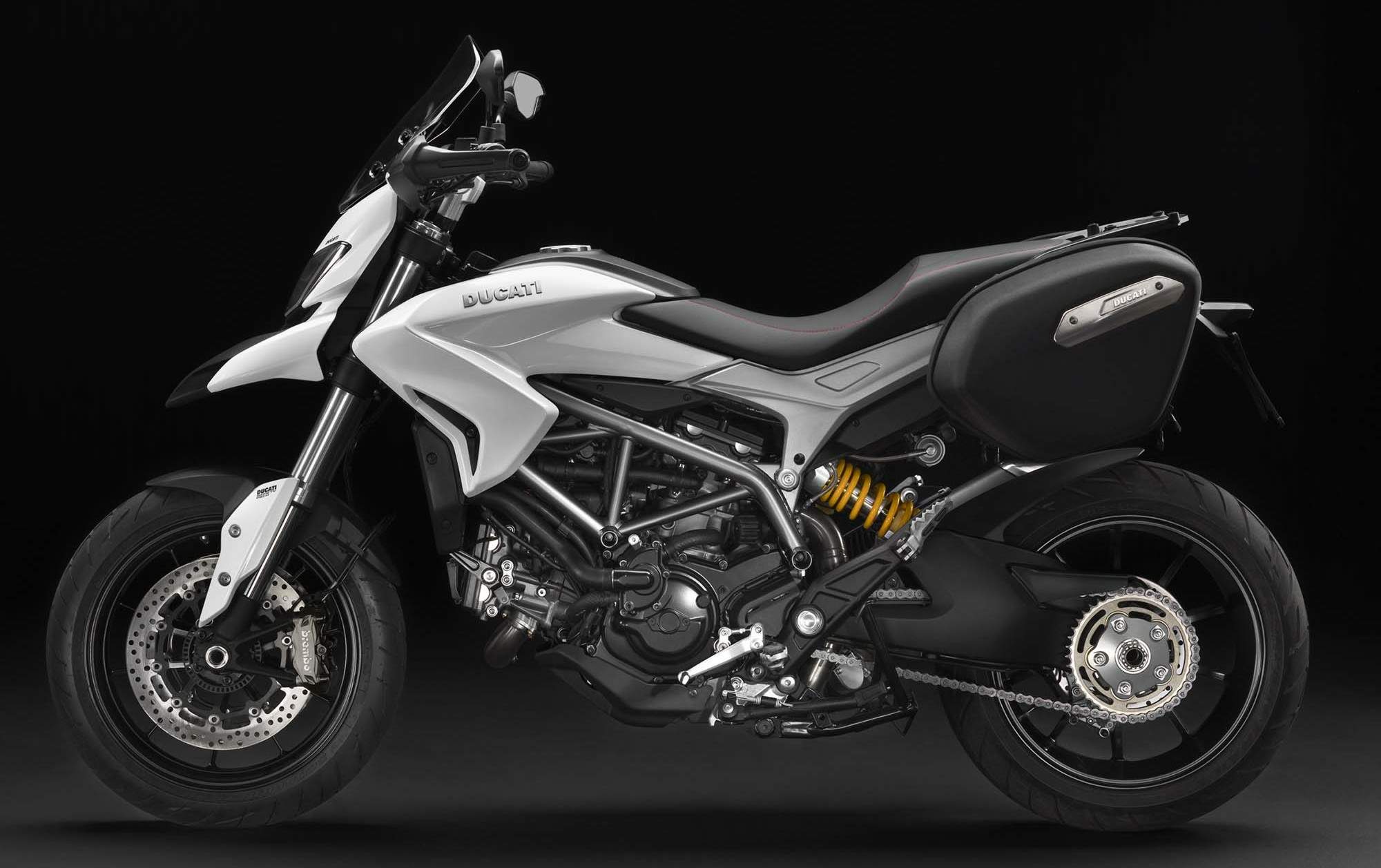
Hypermotard
The Hypermotard moves into the next generation with a brilliantly designed and engineered motorcycle that introduces a new 110hp liquid-cooled engine and improved ergonomics, while maintaining its incredibly compact and minimalist character. Providing ideal access to this exciting family, the Hypermotard integrates the Ducati Riding Modes of Sport (110hp - High), Touring (110hp – Medium) and Urban (75hp – Low) with the Ducati Safety Pack of ABS and DTC to become an exciting motorcycle for everyday use and the ideal choice for the urban commute.
Weighing in with an impressive dry weight of 175kg (385.8lb), the new generation Hypermotard’s attention to the “ergonomic triangle” of handlebars, seat and footrests, provides an even more commanding riding position, with bars moving further forward and higher up, and the footpegs a comfort-enhancing move further forward.
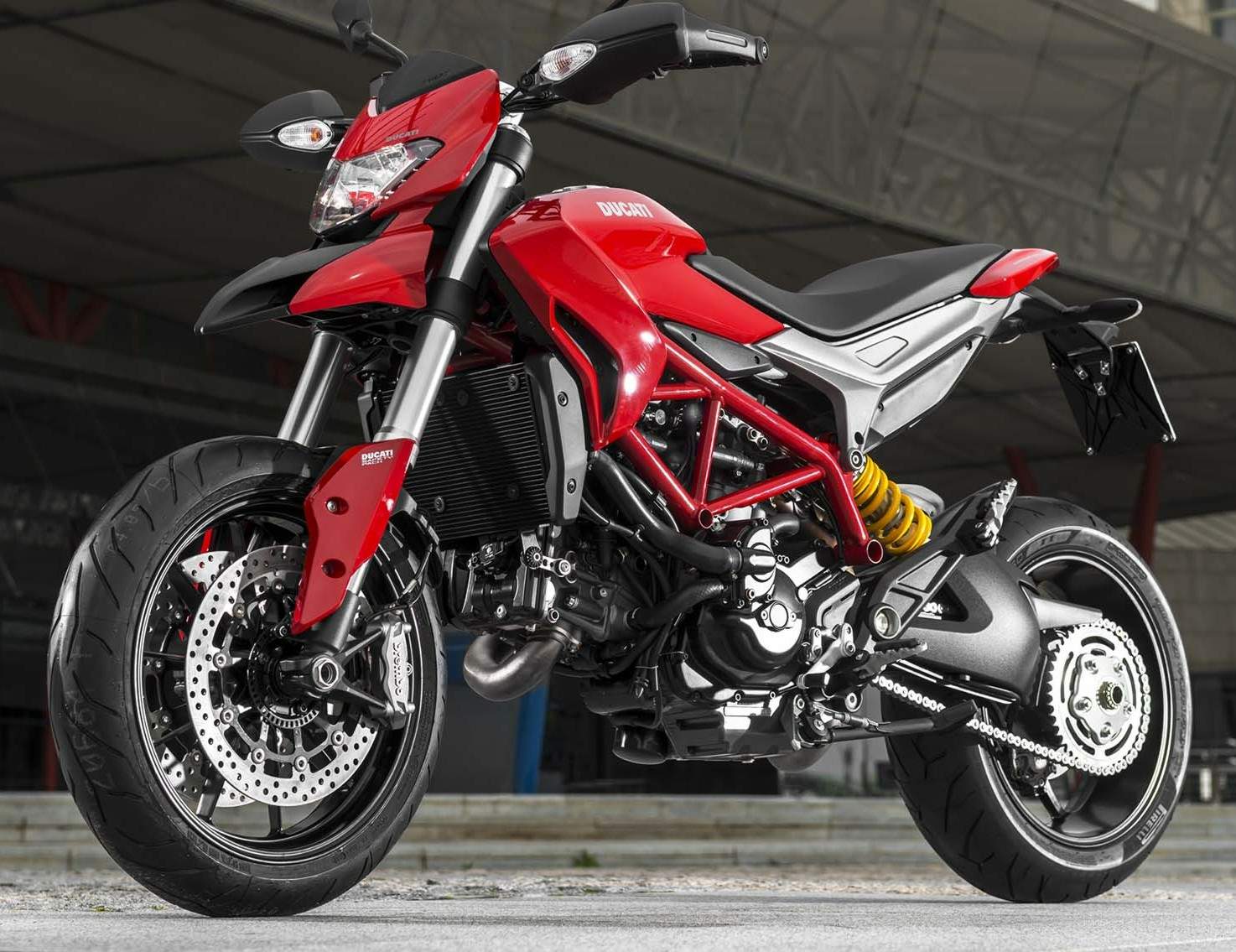
Front suspension is taken care of with 43mm Kayaba usd forks, providing a stroke of 170mm (6.7in) and gripped by clamps in cast aluminium fitted with rubber-mounted bar-risers for the chromed steel handlebars.
Rear suspension duties are managed by a single Sachs rear shock absorber with rebound damping and spring preload adjustment. It operates with a brand new and beautifully engineered aluminium, single-sided swingarm, offering 150mm (5.9in) of rear wheel travel.
The Hypermotard is fitted with Pirelli Diablo Rosso II tyres in 120/70 x 17 for the front and 180/55 x 17 for the rear, mounted on latest generation 10-spoke 1199 Panigale-style cast aluminium wheels with 3.5in front and 5.5 rear rim widths. The Hypermotard is finished in Ducati red or dark stealth with a red Trellis frame and black wheels.
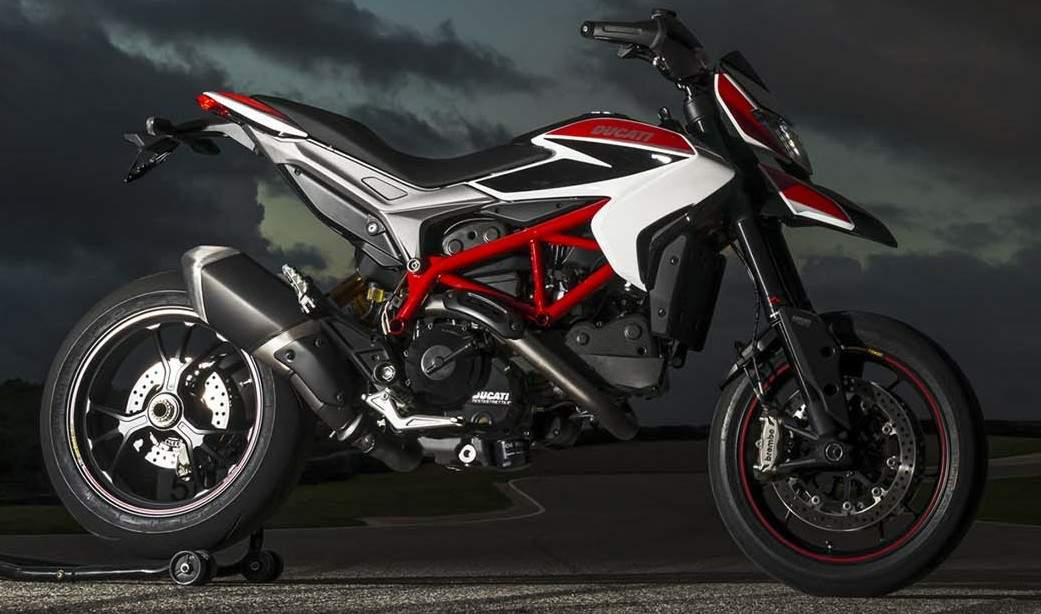
Ducati Hypermotard Features and Benefits
Design
The Hypermotard prototype was an instant success when first shown in 2005 and
soon became a top seller when its production started in 2007. Since then, its
unique design has excited riders around the world and praise for this thrilling
and versatile model has never stopped – and neither has its development.
2013 sees the introduction of the next generation design, embracing the original character and enhancing its adventurous dirtbike-inspired look with visibly high ground-clearance, sharp and high tail-piece and thin waistline - design elements that characterise this type of motorcycle, whether used for road or track While the new Hypermotard maintains the concept of off-road handguards, it now introduces a new style of rear view mirror that follows the model’s clean design continuity. Attention to the detail of flowing lines has resulted in maintaining the essential, minimalist image of the family, even with the complexity of packaging a liquid-cooled engine. Proportion, ergonomics and practicality shaped this new generation of Hypermotard and the integration of Ducati’s latest technologies, such as second generation Testastretta 11° engine, Ducati Safety Pack, Riding Modes and LED illumination, underlines its absolute Ducati character.
Chassis
The Hypermotard has a new 34mm diameter tubular steel Trellis frame with 25.5°
of rake and trail and offset of 104mm (4.1in) and 30mm (1.2in) respectively,
providing a sure-footed, stable “feel” without compromising the Hypermotard’s
character-forming agility. The frame marries to a die-cast sub-frame and
incorporates a Multistrada-like techno-polymer mid-section as part of the
assembly.
The Hypermotard retains its highly manoeuvrable 70° of lock-to-lock steering movement, while the wheelbase now increases to 1500mm (59in), further enhancing the Hypermotards stability at speed. A totally revised fuel tank has increased capacity by 3.6 litre (0.9 US gal) to 16 Litres (4.2 US gal), improving the overall autonomy of the Hypermotard while maintaining its slender waistline and compact silhouette.
Instrumentation
The Hypermotard’s compact instrumentation console has been designed with warning
lights across the upper section, which illuminate for neutral, turn signals,
high-beam, rev-limit, oil pressure and fuel reserve and an LCD screen with dot
matrix area below for all other information.
The screen presents data for speed,
rpm, total mileage, trip1/trip2, engine coolant temperature and ambient air
temperature and time. Additionally, the display also presents current fuel
consumption, average fuel consumption, average speed, and journey time.
The display constantly shows the selected Riding Mode, including the associated
ABS and DTC level programmed, with all three Riding Modes easily changed, while
stationary or in motion, by simply scrolling through displayed modes using the
indicator cancel button.
When stationary, buttons on the left-hand switchgear can be used to enter a setting menu from where adjustments to the various functions can be made including personalised ABS (1-3+OFF), DTC (1-8+OFF) and power delivery via Ride-by-Wire (Low-Medium-High). All settings are saveable in the instrumentation’s memory and can easily be returned to factory settings with a simple default function.
The system can also memorise and list the last 30 recorded lap times by using the high-beam flash button as a stopwatch, each lap time also memorising the lap number and the corresponding maximum speed and rpm during that lap. The instrumentation is also system-ready to accept the heated grips Ducati accessory, which then produces its own control menu, selectable by scrolling through with the engine starter button.
Lighting
The headlamp uses a very compact and lightweight assembly, which employs a
single parabola for high and low beam functions using a blue vision bulb and LED
positioning light. For the rear, a specially designed strip of LEDs, enhanced by
a high diffusion lens shaped into the sleek lines of the tailpiece, acts for
both rear light and brake lights. Front directional indicators are stylishly
integrated into the handguards, keeping the lines of the Hypermotard as clean as
possible. A hazard light function is also added to the new
Hypermotard models, activated by holding the left-turn signal button on for four
seconds.
Controls
The Hypermotard’s full Ride-by-Wire introduces a new and compact electronic
twist-grip, perfectly matching the minimalist styling of the model’s slim-line
switch bodies. They house easy-to-use switches and buttons, and feature a unique
weapons-like 'trigger catch' that slides down to cover the starter button when
the killswitch is activated. All models now have conventional control cable
actuation for the clutch and four-point adjustable levers for the front brake,
five-point on the SP. Black finished footpeg supports are formed in high
pressure die-cast aluminium with integrated heel guards and support rear brake
and gear shift pedals in forged aluminium.
Ducati Safety Pack (DSP)
Ducati’s Riding Mode technology incorporates three-level ABS and eight-level DTC
to introduce the Ducati Safety Pack (DSP) concept to the Hypermotard family,
further underlining the focus on performance safety.
Ducati Riding Modes
Ducati’s industry-changing Riding Modes effectively offer optimised settings
appropriate to rider and environment by selecting from a choice of three pre-set
modes according to model. Each Riding Mode is pre-programmed to instantly change
engine character, ABS and DTC intervention - even while riding. The modes are
made possible by combining a number of class-leading technologies.
An electronic Ride-by-Wire (RbW) system administers different mappings to regulate power delivery, while the Ducati Traction Control system (DTC) uses eight levels of system interaction to enhance control by reducing rear wheel-spin and the ABS processor provides pre-programmed levels of anti-lock braking.
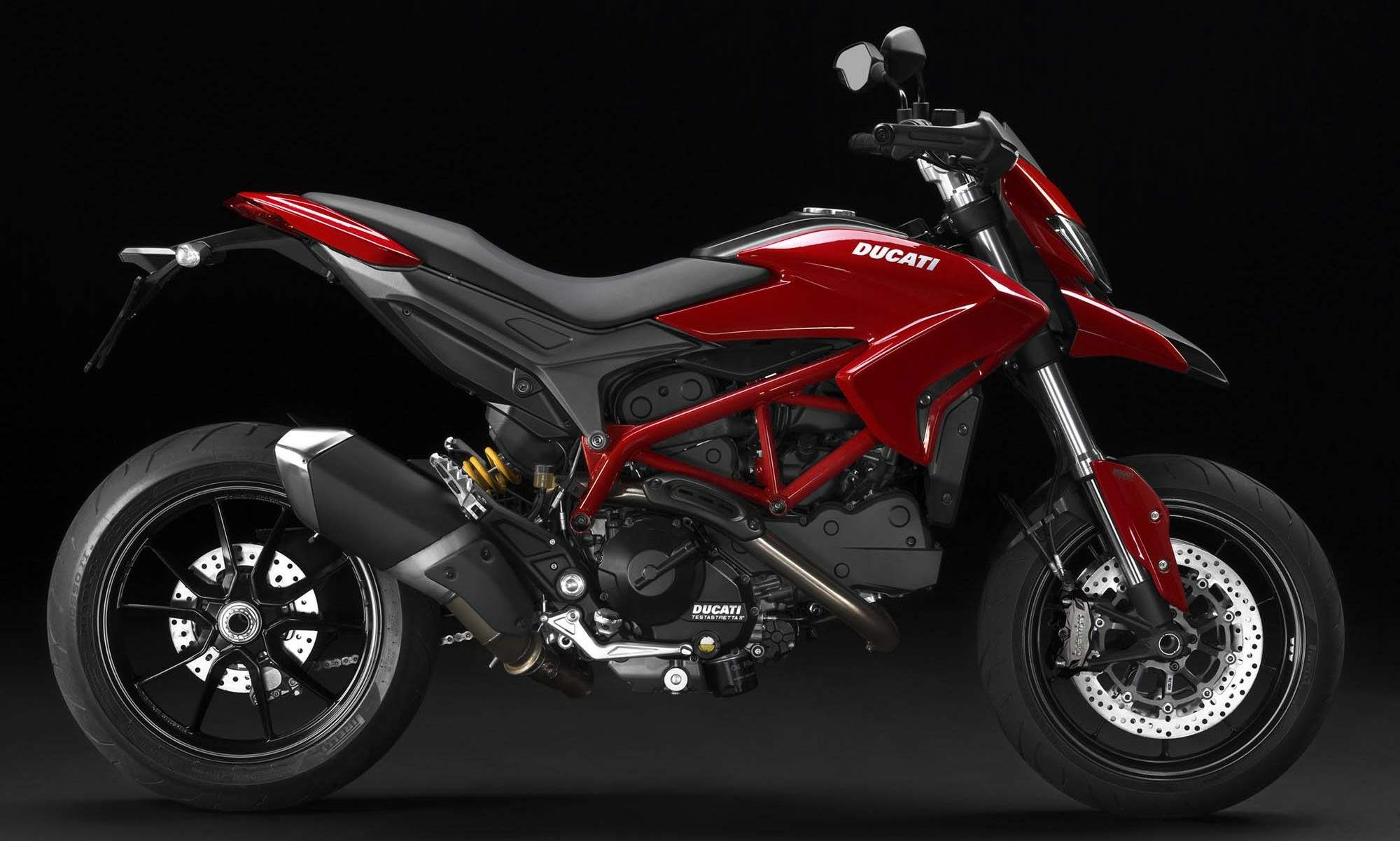
Hypermotard Riding Modes
Sport
The Sport Riding Mode provides 110hp, delivered with a “High” RbW throttle
response, reduced DTC system intervention and level-one ABS of high braking
performance with reduced lift-up prevention.
Touring
The Touring Riding Mode provides 110hp, delivered with a “Medium” RbW throttle
response, increased DTC system intervention and level-two ABS with maximum
braking stability and lift-up prevention.
Urban
The Urban Riding Mode provides 75hp, delivered with a “Low” RbW throttle
response, further increased DTC system intervention and level-two ABS with
maximum braking stability and lift-up prevention.
Ride-by-Wire (RbW)
The Ride-by-Wire (RbW) system is an electronic interface between the twistgrip
and the engine which decides the ideal power response depending on the Riding
Mode selected and according to the rider’s throttle input. The twistgrip no
longer uses a cable to control the throttle body butterflies, but instead
delivers a signal to a control unit, which in turn operates the butterfly
opening. The RbW system enables the use of three different mappings to regulate
the power delivery. The three maps offer 110hp with a “high” sportstype
delivery, 110hp with a “medium” progressive delivery suitable for touring and
75hp with a “low” reduced
delivery for city or rain use.
Ducati Traction Control (DTC)
The Ducati Traction Control is an intelligent system which acts as a filter
between the rider’s right hand and the rear tyre. Within milliseconds, DTC is
able to detect and then control rear wheel-spin, considerably increasing the
bike’s active safety and performance and an important component of the Ducati
Safety Pack (DSP). The new Hypermotard uses the very latest DTC software, now
optimised with seamless intervention to ignition timing only.

The system offers eight ‘levels of sensitivity’, each programmed with a level of rear wheel-spin tolerance in line with progressive levels of riding skills classified from one to eight. Level one is programmed to offer the least amount of interaction while level eight uses the most amount of interaction. DTC is an integral part of the pre-programmed Riding Modes on all Hypermotards.
DTC levels are factory pre-set in each of the three Riding Modes, but can be individually customised and saved to suit the rider by accessing the set-up menu within each mode. A ‘Default’ option is available to easily return all settings to factory pre-sets.
Bosch Brembo Braking system with
3-level ABS
Included as an integral part of the Ducati Safety Pack (DSP), the 2013
Hypermotards are equipped with the Bosch ABS 9MP controlled Brembo braking
system, an impressive combination of state-of-the-art security and proven
performance. Shorter stopping distances with enhanced stability are vital
prerequisites for all motorcycles, but adding full Riding Mode interaction takes
Hypermotard braking to the next level.
The front brakes use twin radially-mounted Brembo, four piston, Monobloc M4-32 callipers actuated by master cylinders with a four-point adjustable lever on the Hypermotard and five-point on the high performance radial master cylinder of the SP. The fronts grip 320mm discs, while a single 245mm disc on the rear is gripped by a single Brembo calliper. Typical of all Ducatis, these components ensure high performance braking and set the standard in this segment.
Both 2013 Hypermotard models are fitted with the Bosch-Brembo ABS system as standard equipment, delivering outstanding braking performances in all conditions and providing a major contribution towards performance safety. An option to disable the ABS in each individual Riding Mode is available via the instrumentation, and the system allows the setting to be saved and memorised at the next ignition-on.
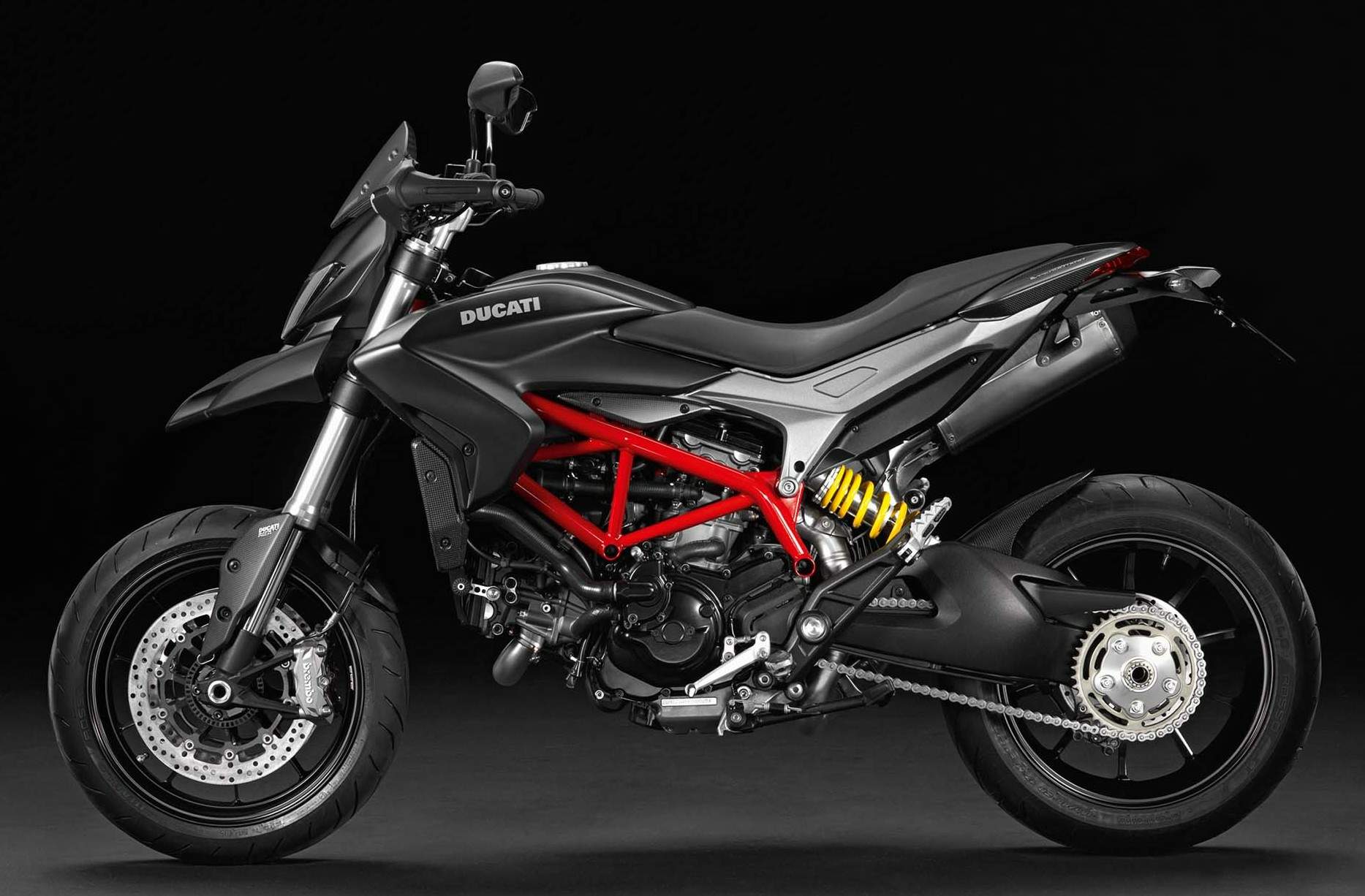
Introducing the 821cc Testastretta
11°
When developing the new power unit for the next generation Hypermotard,
engineers analysed capacity and bore/stroke ratio to create the optimum
combination of tractability and Hyper performance. The 821cc Testastretta 11°
engine introduces and ideal, all-round performance-producing 110hp (80.9kW) @
9,250rpm with a wide and ride-enhancing 65.8lb-ft (9.1kgm) of torque @ 7,750rpm
underlining its pure Ducati character.
The four valves per cylinder, liquid-cooled engine has a compression ratio of 12.8:1 and measures 821cc from an 88mm x 67.5mm bore and stroke, which provides a wide range of torque and an impressive and practical peak horse power value. The engine, which is cooled by a high efficiency radiator mounted with twin electric fans, breathes through two 52mm, full Ride-by-Wire throttle bodies which integrate three maps into the Riding Modes.
The new 821cc Testastretta 11° adopts a number of operation-enhancing features introduced in the second generation Testastretta 11° DS for the 2013 Multistrada, including repositioned fuel injector spray targets and a secondary air system. In order to achieve a smoother cycle-to-cycle engine operation, it is necessary to increase the fuel injected during specific engine operations, and to achieve this without affecting emissions, a secondary air system has been used. This optimisation of fuel-mapping without compromising emissions is achieved by completing the oxidisation of unburned hydrocarbons, which reduces HC and CO levels. The system is activated when the engine ECU recognises specific conditions in the engine’s operation via the lambda and throttle opening sensors. It then opens a valve enabling a flow of clean air from the main airbox to a reed valve situated in each cylinder head, which enables one-way flow into an air gallery exiting into the exhaust port close to the exhaust valve. Entering the hottest point of the exhaust gasses, the fresh charge of air enhances the burn environment, eliminating any unburned fuel that escapes during the exhaust cycle under certain conditions.
For increased user-friendliness, Engineers reduced the amount of valve over-lap from around 40° - typical in performance engines that operate constantly at high RPM - to just 11°. This reduced peak horse-power slightly, but enhanced mid-range and overall smoothness - perfect prerequisites for the extreme versatility of the new Hypermotards.
The overlap angle is defined as the interval of crankshaft rotation, measured in degrees, during which both the intake and exhaust valves are open at the same time. This overlap occurs between the end of the exhaust stroke and the start of the intake stroke. On the Testastretta 11° engine, this angle has been reduced and the fresh inlet flow less compromised by the exiting exhaust gases, resulting in a much smoother combustion, improved fuel economy and lower exhaust emissions. Unburnt hydrocarbon emissions (pre-catalyser) and specific fuel consumption (and consequent CO2 emissions) are considerably reduced.
The new engine is equipped with an APTC, oil bath clutch with ‘slipper’ function and light feel at the lever. Its design uses a progressive self-servo mechanism that presses the plates together when under drive from the engine, enabling the reduction of the clutch spring rates. Now further simplified, in true Hypermotard style, with the use of a control cable actuation, it achieves an even lighter clutch lever at the handlebar, ideal in stop-start traffic or long journeys. When the drive force through the transmission is reversed (over-run), the self-servo mechanism also reverses, reducing the pressure on the clutch plates and enabling them to provide a race-like ‘slipper’ action. This reduces the destabilizing effect of the rear-end under aggressive down-shifting and provides a much smoother feeling when closing the throttle or down-shifting under normal riding conditions.
The completely new 2-1 exhaust system runs through 50mm headers, and is controlled by an electronic exhaust valve before passing into the new single silencer, black finished with a polished stainless steel endcap.
The system uses new sound-absorbing technology to achieve such a compact layout and is completed with catalytic converter and two lambda probes for optimum Euro 3 emissions management.
A milestone 30,000km between major services The 821cc Testastretta 11° engine reaches another milestone in Ducati’s constant investment in quality by enabling the distance between major service intervals (valve clearance check) to be set at an owner-friendly 30,000 kilometres (18,000 miles).
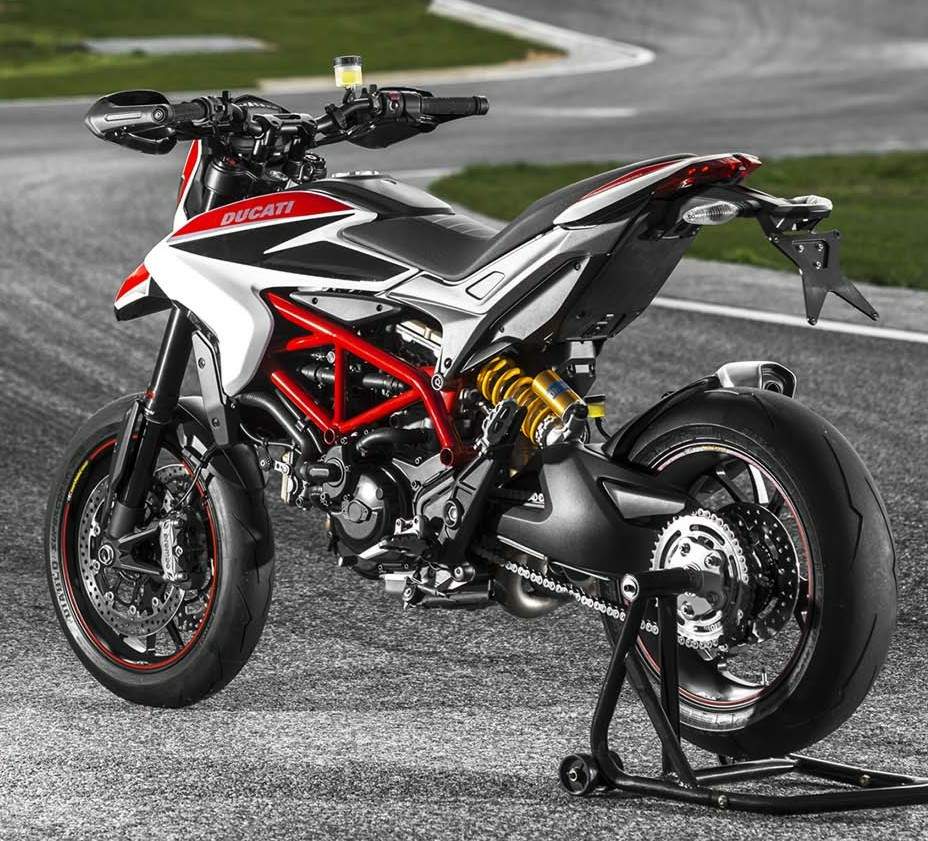
|
Any corrections or more information on these motorcycles will be kindly appreciated. |